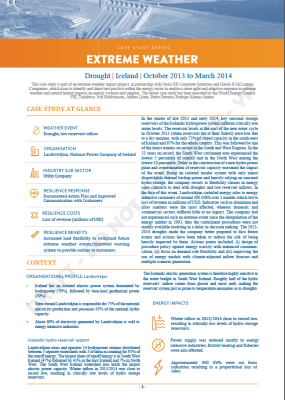Meeting the challenge of transition to decarbonised, affordable and sustainable energy systems means that many people now depend more than ever on weather for their energy. Meanwhile, existing energy infrastructures are exposed to more frequent and severe events, as climate change momentum continues to build.
In a world characterised by opportunities for digital prosperity, converging and decentralising technologies and the continued concentration of people and assets in ever-larger cities, extreme weather events – fires, floods and ice storms - and natural hazards – earthquakes, tsunamis and volcanic eruptions – are emerging and systemic risks. Governments and businesses are challenged to appreciate and address the broader and faster shifting landscape of risk to an embedded energy system. Cascading failures present a new threat potential that cannot be addressed fully by mitigating risks to specific parts of the system.
Drawing on real experiences, this online resource provides a blueprint for building dynamic resilience to extreme weather events. 10 learning reviews identify the system failures triggered by extreme weather events, the impacts these failures, and lessons learnt from mitigation and recovery.
The extreme weather impact case study project, in partnership with Swiss Re Corporate Solutions and Marsh & McLennan Companies, aims to identify and share best practice within the energy sector to enable more agile and adaptive responses to extreme weather and natural hazard impacts on energy systems.

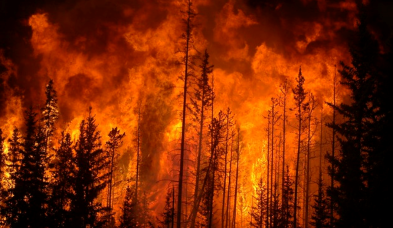
The Fort McMurray fire burned 590,000 hectares, led to evacuation of 88,000 people, 2,400 homes and buildings were destroyed, and oil and gas operations and assets were threatened. 40 million barrels of product were deferred, contributing to a 1% slump in GDP.

California’s worst wildfires in its history during 2017 and 2018, led to over 150 deaths, and damaged over 14,000 homes and 28, 000 structures. Economic losses exceeded $20bn in both years. Local utility declared bankruptcy as a result in the face of related costs and class action liability.
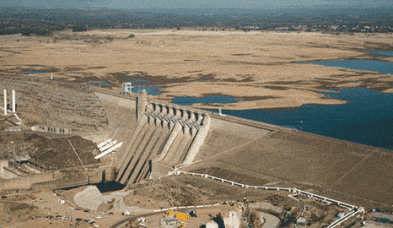
El Nino associated drought decreased water levels in hydropower dams by 60-70% at the same time as hot weather increased electricity demand and back-up thermal plants faced operational problems. Programmed blackouts were considered to deal with a cumulative energy shortage of 200 MW and electricity spot prices rose 800%.
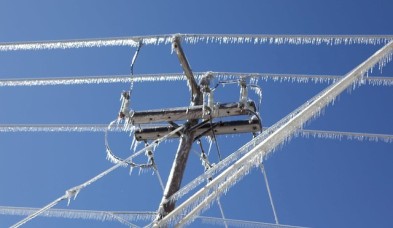
Three successive storms left up to 110 mm of ice over the south of the province damaging 24,000 poles, 900 steel towers and 3,000 km of lines and left 1,393,000 customers without power. Damages totalled C $1.656 billion.
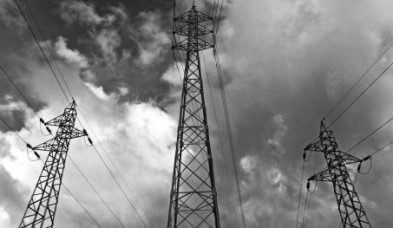
In December 1999 Europe was hit by three extreme windstorms which reached over 118 km/h) and attained peak wind speeds of over 180 km/h. There were damages to medium and low voltage grid infrastructure and major transmission lines and 3.45 million customers were left without electricity.

In October 2018, hurricane-force winds with average speeds of 90km/h and gusts of 200km/ hit northern Italy for 3 days. The storm damaged T&D infrastructure, caused over 90 major blackouts for residential and industrial clients, and left a 5000MW gap in electricity supply.

The Western Cape experienced below average rainfall over the period 2015-2017, which led to the worst drought since 1904 and an unprecedented water shortage. Cape Town was particularly affected by this rainfall deficit. It directly impacted the area surrounding the six large reservoirs that provide fresh water to the city’s 3.7 million residents.

Record breaking weather and extreme bushfires in January and February 2009 caused 173 deaths, destroyed 2,133 houses and other assets. Five of the major fires were caused by failed electricity assets and led to the largest ever class action settlement. SPAusnet paid out A$378.6m. State of Victoria paid out over A$100m. Utility Services Corpn paid out $12.5m. Liability not accepted.
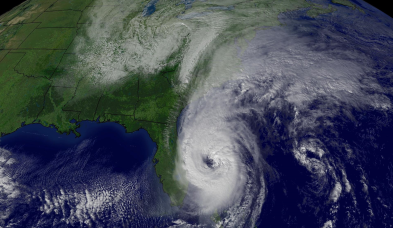
Typhoon Mangkhut was the most intense storm in Hong Kong’s recorded history with wind gusts up to 256 km/h and 4m storm surges. Yet less than 2% of customers experienced disruption to their electricity supply due to effective risk mitigation, planning and response.

On September 4, the most powerful typhoon to hit Japan in 25 years hit the western part of the country and caused severe damage to the power infrastructure due to fallen trees, floods and landslides. Nearly 3.4 million households experienced electricity outages and some faced blackouts for over 6 days.

Over the past 20 years, there has been an increasing trend of severe storms and heavy snow loads on trees leading to large-scale disturbances in distribution grids.
Severe disturbances in electricity distribution systems have occurred in the years 2001, 2003, 2010, 2011, 2012 and 2017. A large number of trees have fallen onto overhead lines as a result of strong summer and winter winds or large amounts of wet snow on trees. In the most severe disturbances, 100 000–400 000 DSO customers have experienced lengthy interruptions at the same time.

The Mekunu cyclone was equivalent to a category 3 hurricane on the Saffir Simpson scale with wind speeds of 170 km/h and gusting of up to 200 km/h. Around 328 mm of rainfall occurred within 36hrs in Salalah, compared to an annual average of about 130mm. Another city - Dhalqut - received 540 mm of rain. Mudslides and flash floods occurred with damages to roads and infrastructure, and 3 casualties reported. Disruption to electricity supply was minimal and where it did occur, the recovery process was prompt [98% of electricity supply restored within 8 days]. Cyclones striking the Arabian Peninsula are rare but not uncommon. An earlier Super Cyclone - Gonu hit Oman in 2007, with a death toll of 12 people and severe economic and structural damages. Cyclones usually impact the eastern provinces, while Mekuno made landfall in the southern province of Dhofar.

In the winter of late 2013 and early 2014, key seasonal storage
reservoirs of the Icelandic hydropower system suffered critically low
water levels. The reservoir levels at the start of the new water cycle
in October 2013 (when reservoirs are at their fullest) were low due
to a dry summer, with only 73% of stored capacity in the south-west
of Iceland and 87% for the whole country.
A diverse group of experiences from around the world (10 in total) identify the system failures triggered by the extreme weather events, the impacts of these failures, and lessons learnt from mitigation and recovery. The learning reviews demonstrate how the Council’s Dynamic Resilience Framework can be used in event response analysis. Applying the Framework criteria helps companies identify potential gaps and strengths in resilience.

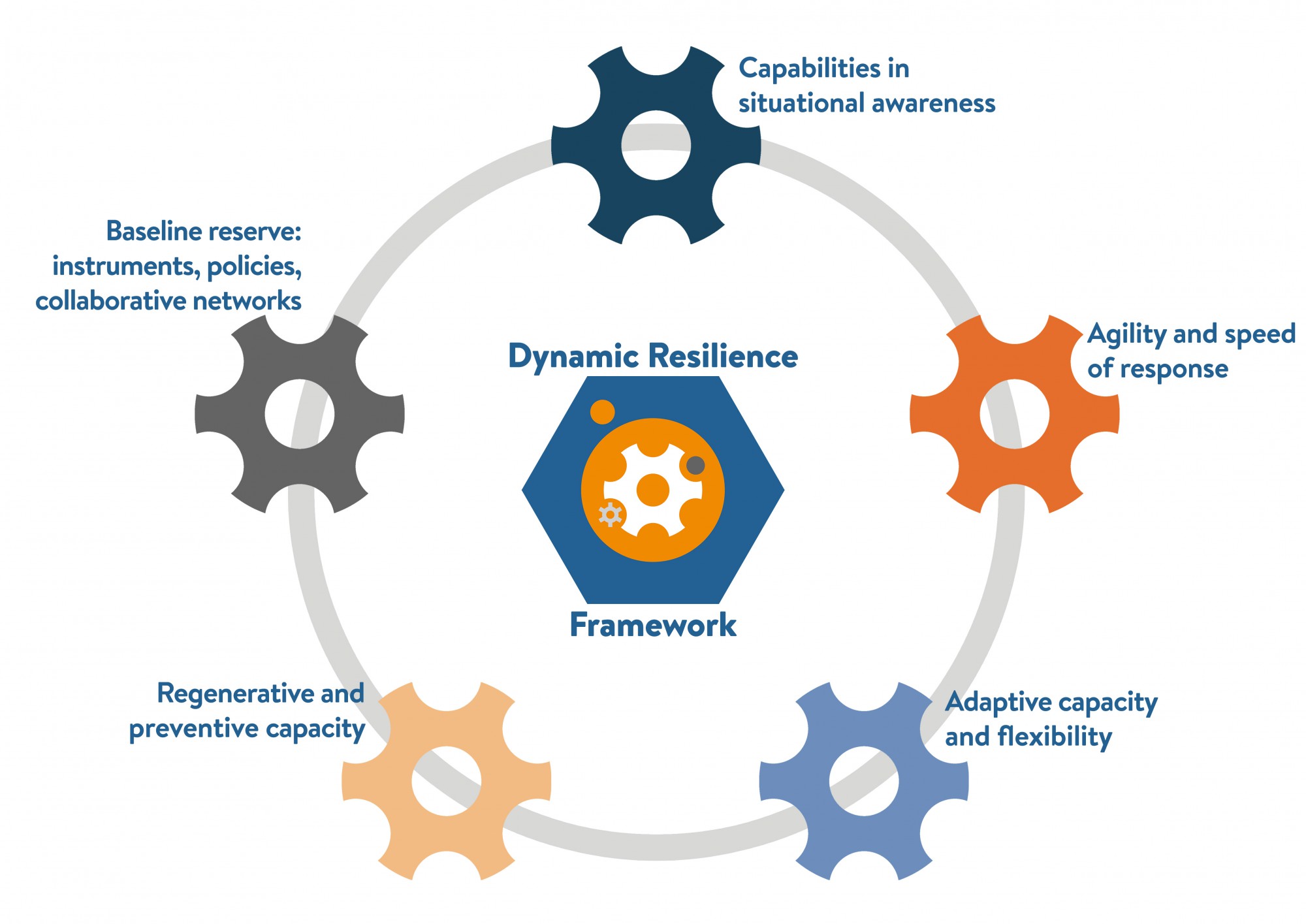
These are the pre-existing emergency response policies and systems that a firm or country has in place and has reheared with relevant stakeholders and wider communities. They will include stockpiled fuel / equipment, mutual aide schemes / networks but also some awareness of how to use these in an emergency (i.e. testing, crisis simulation, etc). The importance of improvisiation of the plan is tested through regular exercise and during crisis.
This is the ability to understand / assess and constantly refresh the landscape of emerging and systemic risk and risk cascade potentials through a combination of threat assessment and horizon scanning in addition to the practical information gathering in a crisis to understand what is actually going on to determine how to respond. Communication planning needs also to be regularly reviewed.
Linked closely to situational awareness, this is the capability to assess what is happening and deploy the most effective mitigation and/or adaptaion plans quickly.
Ensuring the response plans can evolve or adapt to changing circumstances / information. No response plan can cover all eventualities so having strong adaptive capability is essential to DR.
Regenerative / Preventative capacity – the immediate aim in a disruption will be to return to “normal operations” as effectively as possible. At more advanced levels, a creative/transformational approach can be taken, incorporating interactive adaptation and collaborative innovation, which can enable new synergies and net positive impact, rather than return to what was previously accepted as the normal/steady state.
The 10 learning reviews were analysed for common and exceptional examples of best practice and lessons learnt. These emerging ideas for successful resilience were categorised using the Dynamic Resilience framework to provide as an evolving checklist for resilient planning and adaptive response policies.
The key findings represent the shared learning of energy experts - producers, transmission and distribution system operators, policymakers and regulators - across different world regions. Key learnings include:
1. Short term agility in important for market instruments, technological and data solutions, partnerships and collaborations, and communications.
2. Key barriers to dynamic resilience of whole energy systems in transition include lack of coordination, cumbersome contingency plans, underutilised communication, and the rising costs of failure. Improving climate change scenarios modelling and weather forecasting in informing long term adaptation needs are key enablers of dynamic resilience.
3. There is an growing role for simulated, shared experiences, interactive preparedness planning, and other forms of best practice learning to build resilience across increasingly complex and embedded energy systems.
Downloads
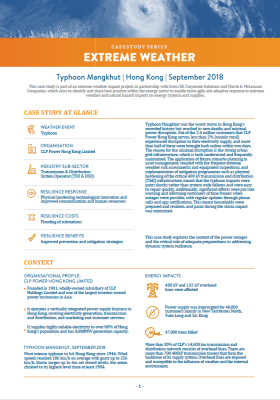
Typhoon Mangkhut Extreme Weather Case Study
Download PDF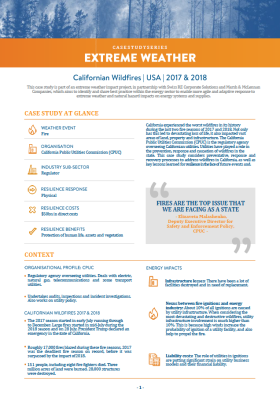
Californian Wildfires Extreme Weather Case Study
Download PDF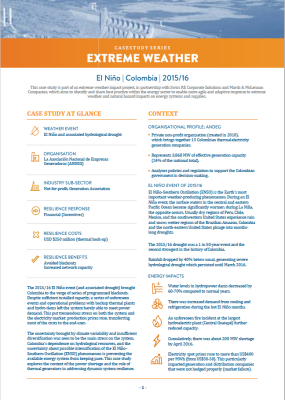
El Niño Colombia Extreme Weather Case Study
Download PDF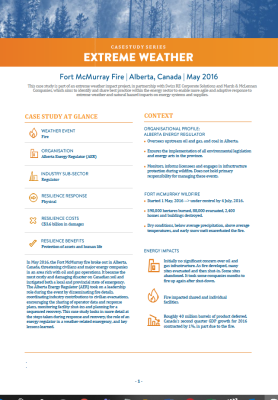
Fort Mcmurray, Canada Fire Extreme Weather Case Study
Download PDF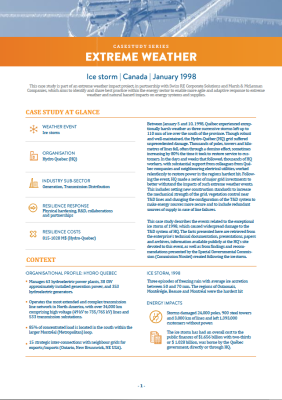
Ice Storm Canada Extreme Weather Case Study
Download PDF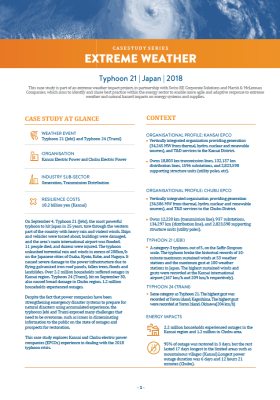
Typhoon 21 Japan Extreme Weather Case Study
Download PDF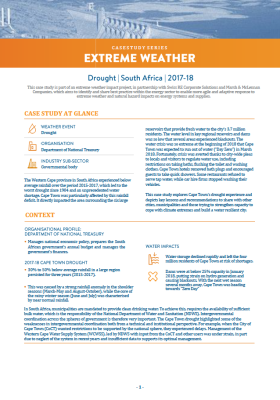
Drought South Africa Extreme Weather Case Study
Download PDF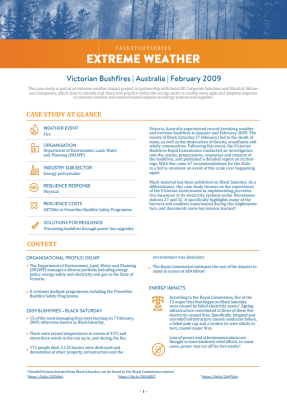
Victorian Bush-fires Extreme Weather Case Study
Download PDF
Wind Storms France Extreme Weather Case Study
Download PDF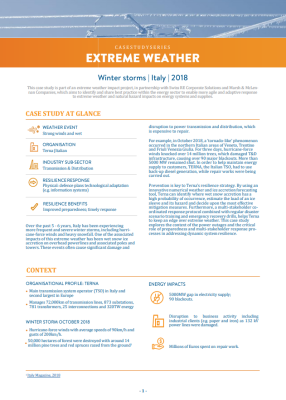
Winter Storms Italy Extreme Weather Case Study
Download PDF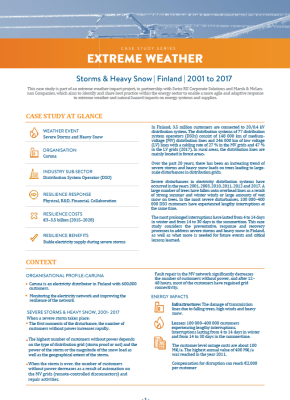
Storms & Heavy Snow Finland Extreme Weather Case Study
Download PDF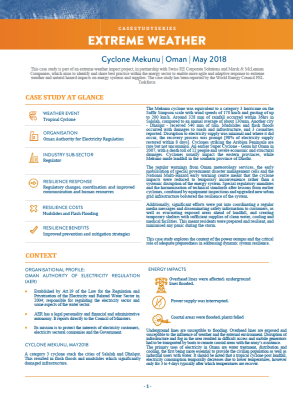
Cyclone Mekunu Oman Extreme Weather Case Study
Download PDF